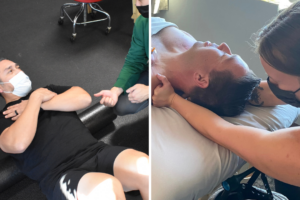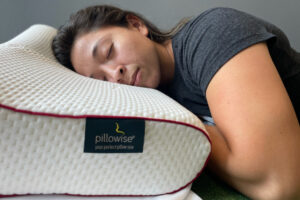
So you just rolled your ankle. It swelled up immediately, and you can’t walk on it. Or maybe you can walk on it, but it’s painful. Should you even walk on it? Should you ice? Lay down on the couch for four days and binge watch Netflix? Go to your physician? Get an X-ray? Call Sports Performance Physical Therapy for an appointment?
Rolling an ankle used to be considered an injury that you could “just walk it off,” and it would heal up without problems. However, newer research is showing that ankle sprains usually continue to create problems for people years after their initial injury. A sprained ankle is at high risk for future ankle sprains, and the development of chronic ankle instability (CAI). Your course of action after an ankle sprain can largely impact your recovery!
Below are the answers to some of the most common questions we get:
How do I know if I should go to my physician and get an X-ray?
There are a few guidelines that we follow when deciding whether or not our clients should get an X-ray after rolling an ankle. These are referred to as the Ottawa Ankle Rules:
– Bony pain/tenderness at any of the following locations:

Medial malleolus (inner ankle bony prominence)
Lateral malleolus (outer ankle bony prominence)
Base of the fifth metatarsal (outer foot bony prominence)

Navicular Bone (bony prominence above the arch at inner ankle)
- Inability to bear your bodyweight for four steps immediately or during the rest of the day
If any of the above apply to you….go to your physician for an X-ray!
None of the above are me: I’m just swollen, but still walking on it, what do I do?
- Generally, we advise our clients to follow the principles of MICE: Mobility, Ice, Compression, Elevation
- Mobility: One of the best ways to prevent stiffness is to continue to allow movement through the joint, so don’t try to immobilize your ankle by laying on the couch all day. We recommend “relative rest,” where you are limiting the amount of walking you’re doing compared to a typical day, but still using your down time to work on some ankle alphabets.
- Ice: Using ice on a new ankle sprain will help with your pain and keep your swelling manageable. Try to ice for about 20 minutes at a time, 4-5 times during the first few days.
- Compression: Along with ice, adding some compression to the ankle can keep your swelling at bay and add make it feel more comfortable. A compression sleeve will also work with your lower limb muscles to keep your blood moving out of the area.
- Elevation: This is our final swelling management trick. Take at least 20 minutes in the morning, afternoon, and evening to lay flat on your back and elevate your ankle above the level of your heart. This will allow gravity to help with the drainage of swelling from the area.

Pro Tip: Combine any two of the above steps for double the healing power! Ice while you elevate, perform ankle mobility exercises with compression, compress while you elevate! (Just avoid mobility exercises with ice since the ice will stiffen up your muscles!)
I have a training session scheduled later this afternoon, can I still go?
Absolutely. Exercise is one of the best ways to keep your body healthy and promote healing, especially during an injury. You might have to modify your workout a little bit on day one though if you’re in pain or not feeling as stable as usual. This might mean subbing out any high impact, high agility, or challenging balance activities (running, jumping, cutting, single leg work) until you’re able to tolerate light jogging again. At this early stage, use pain as your guide, you want to give the musculature time to recover from the over-stretching that occurred during your sprain.
When do I need do see a PT?
The earlier, the better. If you want to get back to the gym, a sport, or your life more quickly, see a PT quickly for an assessment, treatment, and plan. A PT will not only evaluate your ankle and use manual therapy to reduce swelling and pain, but they’ll help you get on track toward strengthening the ankle musculature and restoring your balance, to improve your performance and prevent a second sprain.
The earlier, the better.
As always, I hope this helps! If you have any questions or would like to read about certain topics, send us an email at TeamSP@SportsPerformancePT.com.
-Dr. Marissa Rescott, PT, DPT, CF-L1
For more tips on optimizing athletic performance FOLLOW US on:
- Instagram: http://www.instagram.com/SportsPerformancePT
- Facebook: http://www.facebook.com/SportsPerformancePT
- YouTube: http://www.youtube.com/c/SportsPerformancePT











